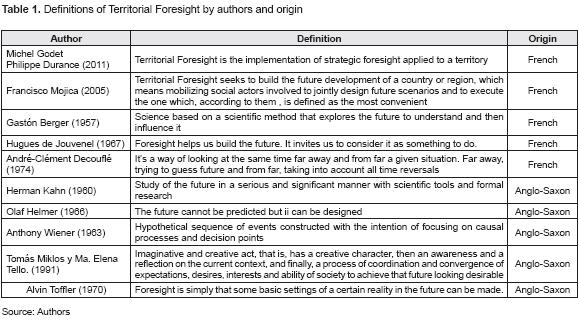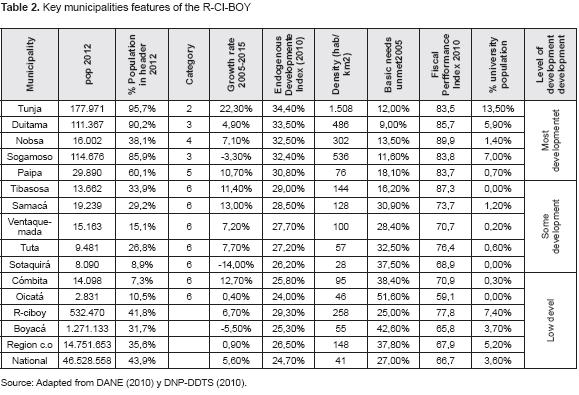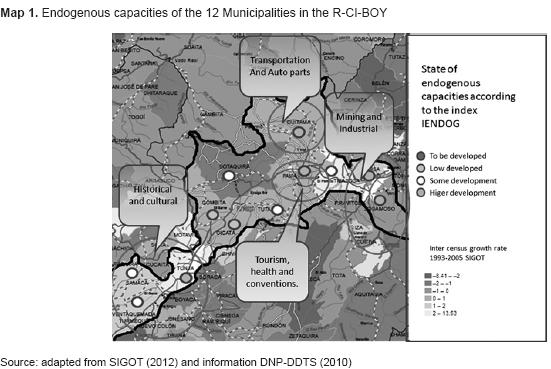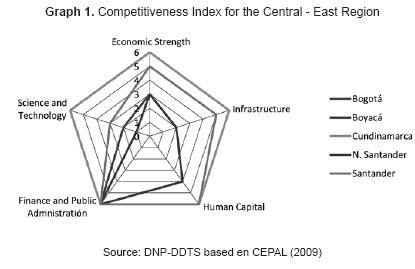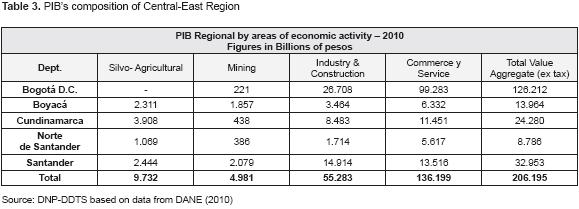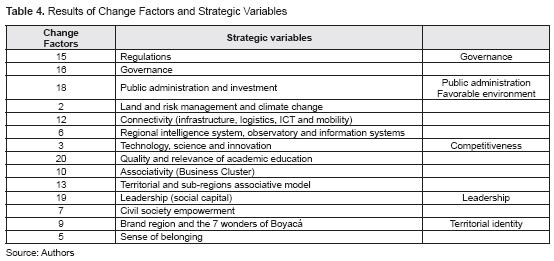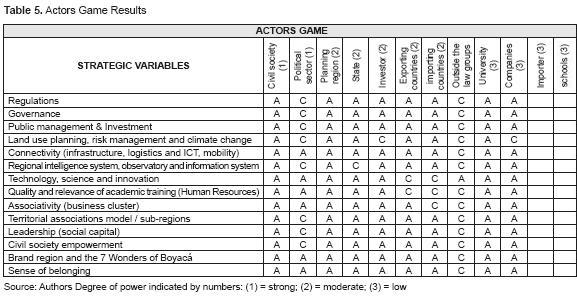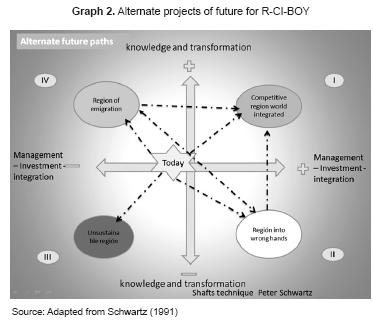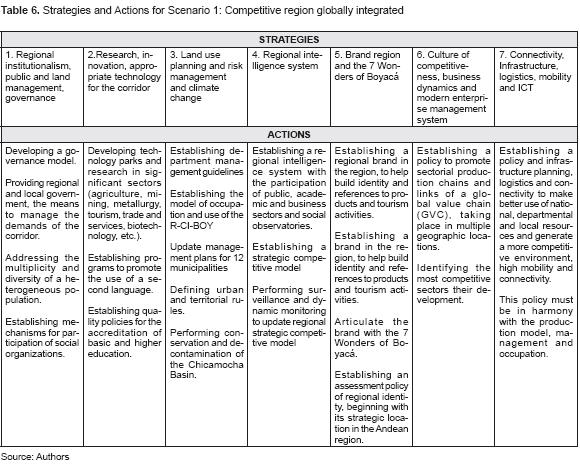Services on Demand
Journal
Article
Indicators
-
 Cited by SciELO
Cited by SciELO -
 Access statistics
Access statistics
Related links
-
 Cited by Google
Cited by Google -
 Similars in
SciELO
Similars in
SciELO -
 Similars in Google
Similars in Google
Share
Dimensión Empresarial
Print version ISSN 1692-8563
Dimens.empres. vol.12 no.2 Barranquilla July/Dic. 2014
Regional development and vision of future of boyacá's industrial corridor*
Desarrollo regional y visión de futuro del corredor industrial de Boyacá
Desenvolvimento regional e visão de futuro do corredor industrial de Boyacá
Francisco José Mojica Sastoque2
José Oswaldo Espinosa Cuervo3
* This article is the result of a research project: A Foresight Analisys of a Region for Economic Planning -- Boyacá's Industrial Corridor Towards 2019, conducted by the Center for Strategic Thinking and Foresight of Externado University of Colombia.
1 Doctor in Dirección Management and Business Organization of the Autónoma University of Madrid. Postdoc in Administration of the Sao Paulo University. Professor of business administration of the Externado University of Colombia. Bogotá-Colombia. Email: julioc.acosta@uexternado.edu.co
2Doctor in Human Sciences and Postdoc in Foresight and Strategy of the Paris Descartes University. Director of the Center for Strategic Thinking and Foresight of the Externado University of Colombia. Bogotá-Colombia. Email: francisco.mojica@uexternado.edu.co
3Master in Strategic Thinking and Foresight and Researcher of the Center for Strategic Thinking and Foresight of the Externado University of Colombia. Bogotá-Colombia. Email: jespinosa@dnp.gov.co
Forma de citación
Acosta-Prado, J. C., Mojica, F. J. y Espinoza, J. O. (2014). Regional development and vision of future of boyacá's industrial corridor towards 2019. Revista Dimension Empresarial, vol. 12, núm. 2, p. 11-28 JEL: R11, R28, R58
Abstract
This article is the result of a research project: A Foresight Analisys of a Region for Economic Planning -- Boyacá's Industrial Corridor Towards 2019.The theoretical foundations of the project were based on Territorial Foresight. The methodology was designed considering the following aspects: (1) Current situation of the region within a Global, National and Regional context; (2) Identification of world trends and technology affecting the region and its productive sectors; (3) Identification of key factors that characterize the region; (4) Prioritization of strategic variables and understanding of the territorial development system. Based on these aspects, four alternate scenarios of possible futures (futuribles) which could take place in the region were constructed. Likewise the most likely scenario "bet scenario" was proposed which was called "Competitive Region - World Integrated". It comes with seven strategies for its concretion from the present time. The study becomes even more important since the region has received funds coming from the National Government as well as from foreign investment interested in strategic projects.
Keywords: Industrial Corridor of Boyacá - Territorial foresight - Regional development - Vision of the future.
Content: Introduction, 1. Theoretical foundations, 2. Methodology of territorial foresight applied to the "region of economic planning of Boyacá's Industrial Corridor" (R-CI-BOY), 3. Strategies and actions for scenario 1, 4. Final considerations.
Resumen
Este artículo es resultado del proyecto de investigación: "Análisis prospectivo de la región económica de planificación - Corredor Industrial Boyacá al horizonte del año 2019". Los fundamentos teóricos del proyecto se establecieron con base en la prospectiva territorial. El desarrollo metodológico se hizo valorando los siguientes aspectos: (1) Situación actual de la región en un contexto mundial, nacional y regional; (2) Identificación de las tendencias mundiales y tecnológicas que afectan la región y los sectores productivos; (3) Identificación de los factores clave, que caracterizan la región; (4) Priorización de las variables estratégicas y comprensión del sistema de desarrollo territorial. Con base en lo anterior se conjeturaron cuatro escenarios alternativos de futuros posibles (futuribles) que pueden ocurrir en la región. Asimismo se propuso el escenario apuesta llamado región competitiva e integrada al mundo, con siete estrategias para su concreción desde el presente. El estudio cobra mayor importancia porque en la actualidad la región cuenta con mayor disponibilidad de recursos de inversión por parte del Gobierno Nacional y, por la inversión del capital extranjero para realizar proyectos estratégicos.
Palabras clave: Corredor Industrial de Boyacá, prospectiva territorial, desarrollo regional, visiones de futuro.
Contenido: Introducción, 1. Fundamentos teóricos, 2. Metodologia de la prospectiva territorial aplicado a la "región de la planificación económica del Corredor de Boyacá Industrial" (R-CI-BOY), 3. Estrategias y acciones para el escenario 1, 4. Consideraciones finales.
Resumo
Este artigo é resultado do projecto de pesquisa: "Análise prospectivo da região económica de planejamento -Corredor Industrial Boyacá ao horizonte do ano 2019". Os fundamentos teóricos do projecto estabeleceram-se com base na prospectiva territorial. O desenvolvimento metodológico fez-se valorizando os seguintes aspectos: (1) Situação actual da região num contexto mundial, nacional e regional; (2) Identificação das tendências mundiais e tecnológicas que afectam a região e os sectores produtivos; (3) Identificação dos principais fatores que caracterizam a região; (4) Priorização das variáveis estratégicas e compreensão do sistema de desenvolvimento territorial. Com base no exposto quatro cenários alternativos de futuros possiveis (eventos futuros) que podem ocorrer na região. Assim mesmo propôs-se o palco aposta chamado região competitiva e integrada ao mundo, com sete estratégias para sua concreción desde o presente. O estudo cobra maior importância porque na actualidade a região conta com maior disponibilidade de recursos de investimento por parte do Governo Nacional e, pelo investimento do capital estrangeiro para realizar projectos estratégicos.
Palavras-chave: Corredor Industrial de Boyacá, prospectiva territorial, desenvolvimento regional, visões de futuro.
Conteudo: Introdução, 1. Fundamentos teóricos, 2. Metodologia de previsão territorial aplicada à "região de planejamento económico do Corredor Industrial de Boyacá " (R-CI-BOY), 3. Estratégias e ações para o cenário 1, 4. Considerações finais.
Introduction
Boyacá's "Administrative Department of Planning" and the "Center of Strategic Thinking and Foresight" of the University Externado de Colombia, conducted in 2010, A Foresight Analisys of a Region for Economic Planning -- Boyacá's Industrial Corridor Towards 2019.
Considering the changes in the context and the emergence of new factors of change it was felt necessary to update and expand the study in order to include new social, economic and environmental challenges. The project was initiated reviewing the following studies: "The development plan for Boyacá 2012-2015" (El plan de desarrollo departamental de Boyacá 2012-2015). "The reform of the general system of royalties" (La reforma del Sistema General de Regalias); "The contract/plan Boyacá on its way to prosperity: the way to achieve the Seven Wonders" (El Contrato Plan "Boyacá camino a la prosperidad", la via de hacer efectivas Las Siete Maravillas); "Boyacá 2019 Vision: the land of freedom and bicentennial prosperity" (La Visión Boyacá 2019: territorio de libertad y prosperidad bicentenaria); "The Regional Strategic Plan of Science, Technology and Innovation - PERCTI- for Boyacá 2012-2022" (El Plan Estratégico Regional de Ciencia, Tecnologia e Innovación -PERCTI- del Departamento de Boyacá 2012-2022).
The study acquires relevance for three reasons: First, the region has financial resources coming from the National Government as well as from foreign investors interested in strategic projects. Ideally, these funds will be directed towards the key factors for the advancement of the region as stated in the most likely scenario (bet scenario). Secondly, due to the progress the country has achieved in land use and business associations, the environment has improved so that the region can be consolidated under a propitious governance framework and; thirdly, in past years several infrastructure developments have been executed such as the highway Bogotá-Tunja-Duitama-Sogamoso that have equipped the region providing privileged conditions for further development. With the proposed complementary projects to update the Foresight study, the intention is to give robustness and content to the region's strategic objectives so that they will contribute to the economic development and integral growth of Boyacá's Industrial Corridor.
The objective of this paper is, first to validate the state of the art and to conduct technological surveillance in light of the new set of opportunities available in the region as a result of new laws and public policies, which will impact the region in the next 6 years. Secondly, to identify change factors, strategic variables and to define hypothesis in order to formulate the "most likely" and relevant scenarios for the region, and finally, to design and validate alternate scenarios for the future which will permit to propose the challenges, strategies and implications in the "bet scenario" for the development of the region.
1. Theoretical foundations
Territorial development is a dynamic relationship between men and his land.
This relationship is in a constant process of transformation searching for a well-being. It is also the result of:
- Multi-dimensional interrelations: geographical, environmental, economic, social, cultural, political and institutional
- Multi-scale: world, national, regional and local
- Multi-actor: ethnic, inter-disciplinary and inter-networks where each individual, social group, organizations and institutions has different degrees of power.
Territorial development is framed by some rules of citizen conduct called governance. Likewise, the development depends, on one hand, of the competence of leaders and actors to come to agreements and adapt to the development model and the occupation of the territory, an on the other, the ability to get and provide resources to meet the agreed objectives.
The achievement of the objectives is proportional to the levels of governance in the territory and its environment. Territories with high levels of governance show high degrees of social and territorial cohesiveness, with strong mechanisms for dialogue and integration, and where the common interests are first. By contrast, in territories with low levels of governance, individual interests conflict with social, environmental, economic, political and institutional issues.
In other words, territorial development is a social and dynamic construction process of interrelationships of human and geographical factors which provides a place with a sense of ownership and specific social behaviors linked to space, place and landscape.
The location of a territory is a social act of registration of a place in the specificity: Where is it? How is it? How is it different? (Mazurek, 2006:11), Likewise, the territory gives a sense of recognition of that place through the identity, governance and the notion of citizenship (Mazurek, 2006:50)
Territorial development is an integral and complex phenomenon which can only be grasped to transform with conceptual frames such as territorial foresight also called "intellectual indiscipline" of French origin. Territorial foresight is applied to space units such as: municipalities, departments, regions, development areas, corridors, among some, in order to identify common visions of the future articulated to regional, national and global dynamics in order to orient strategic actions to be undertaken by actors, institutions and citizens living in or are affected by these areas.
Territorial foresight has expanded worldwide. "The contribution of foresight to the renewal of territorial planning was recognized and substantiated by recent examples of successful practices well widespread (Loinger, 2004; Mousli, 2004; Derné et al., 2008). There is a renewed and stimulating vision of territorial foresight Bailly, 2005, as evidenced by the numerous works published in recent years Courson, 1999; Destatte, 2001; Goux-Baudiment, 2001; Debarbieux, Vanier, 2002; Farhi et al., 2003; Jouvenel, 2004;" Godet y Durance, 2011:95
In the Study "Mapping Foresight in Europe and the rest of the World" conducted by Global Foresight Outlook, (GFO) from the University of Manchester in 2007, using a sample of 1.652 cases covering Five continents: Europe, North America, Asia, Africa and Oceania, the results show how most initiatives to formulate visions of territorial foresight are national (70%) and the rest (30%) are regional.
With the relevance gained by regions or city/regions as a result of the globalization, it is highly likely to expect that this proportion is reversed in coming years.
In Colombia, this trend proved correct in 2011. In fact, the Department of National Planning worked with eight Departments in the formulation of visions for development: Arauca, Atlántico, Boyacá, Cauca, Cesar, Magdalena, Meta and Risaralda. Also Departments such as Antioquia, Valle, Cundinamarca, Huila, Casanare, Norte de Santander, Santander and Caquetá have their foresight visions already made.
Additionally, within the Plans of Competitivenes for the 32 regions of the country, each one has a statement of a vision for the future.
"Territorial foresight is the use of strategic foresight applied to a territory for its development". (Godet y Durance, 2011:87). In other words, it is the construction of social imaginaries (scenarios) of possible futures (futuribles) about a territory.
There are two schools of thought in the construction of scenarios: the French (prospective), defined as the discipline or "intellectual indiscipline" which focuses on the anticipation to clarify current actions in light of the possible and desirable future and the Anglo-Saxon (forecasting or foresight) which is based on forecasts (information and probability assignments) of occurrence of an event, fact, trend or scenario bet.
French Foresight is also considered voluntaristic because it is based in the future (in general, and in particular of a territory, in our case). It is built by social actors in the present, in a complex environment full of uncertainties and risks.
Foresight or "intellectual indiscipline" as Godet calls it, is necessarily trans- disciplinary and collective, and is characterized by a dialectical and rigorous method for clarifying the present and possible future of the territory under a holistic, systemic and complex framework which transcends history.
The future is the result of the exercise of freedom and the will of men, where vision or bet scenario, built collectively, is reflected in the present through actions, desires and dreams. Table 1 presents a summary of Territorial Foresight definitions.
2. Methodology of territorial foresight ap-plied to the "region of economic planning of boyacá's industrial corridor" (R-CI-BOY)
At the methodological level the project was approached in two stages: The first stage, with secondary sources, which means recognizing the State of the Art of the regional development and to identify the technologies that are expected worldwide for the future, through an analysis of Technology Watch and Competitive Intelligence in universal fields of knowledge relevant to the development of Boyacá Industrial Corridor. This activity was carried out by an investigation of documents and Web sites, to And the most significant trends with respect to the R-CI-BOY.The second phase, with primary sources, was conducted with the participation of a number of experts with good knowledge of regional behavior (Expert Group Leaders) representatives of the four social acting sources of development, namely: the State, the productive sectors, the academia and civil society. The discussions with the primary sources consisted of six workshops for the purpose of designing future scenarios of regional development, then choose the most suitable and define the strategies to achieve it.
2.1. State of the Art and Technological Surveillance Study of the R-CI-BOY
2.1.1. "Region of Economic Planning of Boyacá's Industrial Corridor" (R-CI-BOY)
The R-CI-BOY consists of twelve municipalities with the following features (table 2):
The R-CI-BOY has four functional centers of development:
- Historical and cultural, in the cities of Tunja, Samacá and Ventaquemada.
- Tourism and health in the city of Paipa.
- Transportation and auto parts, in the city of Duitama
- Industrial Mining, in the cities of Tibabosa, Nobsa and Sogamoso.
Within the corridor we have Sotaquirá and Tuta with some levels of agricultural development. Also Cómbita and Oicata with low levels of development as seen in the following Map 1:
The R-CI-BOY has a degree of specialization in Tunja, the capital of the department of Boyacá, whith concentration in the service, commerce and administration sectors. The presence of university students in this city is evident. The cities of Duitama, Sogamoso, Paipa y Nobsa have a service and commercial sector accompanied by industrial development in the production of bodyworks, metal, steel, dairy, furniture, and energy generation, among others. Tourism is a very important sector of development for the region and the department. In the seven municipalities of low or some development, the economy is primarily agricultural and service.
The R-CI-BOY is heterogeneous - without social or territorial cohesion. It is articulated primarily by the Highway Bogotá-Bucaramanga. The region has great articulation and market potential with the Llano (flat land) region: Casanare and Arauca as well as Magdalena Medio (Middle Magdalena)
Within the 100 kilometers of the corridor there is a large supply of health facilities, higher education, three airports, four dams, four power generators, three industrial parks, among others. There is however, an urgent need to restructure the territorial productive system and promote a sustainable, equitable, manageable and competitive development. Currently, the corridor presents areas of poverty, population loss, conflict in land use, air pollution, water pollution, environmental degradation and erosion of the Chicamocha river basin, low levels of production, low levels of innovation and Anally an offer of education, science and technology that does not correspond to the demands and possibilities for the development of the department and the R-CI-BOY.
The Boyacá department, has multiple strategic factors to develop tourism such as: the proximity to Bogotá with a potential of 7 million inhabitants, the location in the Andean region, which allows for diverse ecosystems, biodiversity (flora and fauna endemic), variety of climates and of landscapes, historical heritages - colonial and from the independence and archaeological heritage of the first aboriginal, among others. The region also has a good number of hotels and convention centers, which facilitate the development of the sector.
2.1.2. Context of the R-CI-BOY
The reform to the General System of Royalties (Sistema General Regalias - SGR) and its application as a financial and institutional strategy, seeks that Colombia advances in the regional integration reducing territorial imbalances.
The General System of Royalties, involving departmental governments, formed six regions: Caribe, Centro Oriente, Eje Cafetero, Llano, Pacifico and Centro4. The R-CI-BOY is part of the Centro Oriente (East Central) Region, which is the most populous and powerful region in the country.
In the document "Regional Profiles: facts and basic elements for regional development" (DNP, 2012), the East Central Region, is comprised of the departments of Boyacá, Cundinamarca, Norte de Santander, Santander and Bogotá. It occupies 8.72% (99 594 square kilometers) of the national territory.
This region accounts for
- 31.67% of the total population (14.7 million)
- 33.3% (367) of the municipalities of the country.
- 16 cities with over one hundred thousand inhabitants are located here. They are: Bogotá D.C.,, Cúcuta Bucaramanga, Soacha, Floridablanca, Barrancabermeja, Tunja, Girón Piedecuesta, Fusagasugá, Facatativá, Chia, Zipaquirá, Sogamoso, Duitama, Girardot, inhabited by 75.1% of the total population of the region. Three of them, Tunja, Tunja Sogamoso and are part of the R-CI-BOY.
The East Central region has a high degree of functional articulation with the city network and offers important external economies of agglomeration, which facilitate economic growth. After Cundinamarca, the department of Boyacá has a high degree of functional articulation due to its proximity to Bogotá. With the completion of the highway Bogotá-Tunja-Sogamoso-Bucaramanga the integration will be stronger.
The competitiveness index established by CEPAL for the region is 76.4 it being the highest in the country. Strengths are highlighted in public management and finance in all departments of the region as well as in human resource training and service delivery, resulting in better conditions for regional competitiveness. However, in infrastructure, and science and technology issues, there is a great disparity between Bogotá and Cundinamarca, against Boyacá and Norte de Santander.
In terms of economic strength, the highest levels are found in the DC, Cundinamarca and Santander, while Boyacá and Norte de Santander show lower levels. Boyacá is very weak in science and technology, infrastructure, and economic strength which affect the competitiveness of the region.
The total domestic product of the Central-East amounted to 206.195 billion, accounting for 41.4% of GDP, being the highest share among all regions (Graph 1).
Production in Boyacá, table 3, is concentrated in the areas of trade and services, industry, construction, forestry and Agro-livestock.
2.1.3. Development Plan for the Department of Boyacá
The Development Plan is called "Boyacá se atreve 20122015" (Boyacá dares 2012-2015) and is based on eight strategic axes (Ave vertical and three horizontals).
The Ave vertical shafts look to:
1) Generate economic development without harming the environment.
2) Transform its social reality and position it before the world.
3) Generation of added value in the economy to increase its wealth.
4) Promote good goverment.
5) Integrate Boyacá within the region and into the world.
These strategies are supported by three horizontal shafts:
1) Adequate road infrastructure for regional integration and economic development of its potential.
2) Safety to attract investment
3) Incorporate science, technology and innovation as the most expeditious way to generate added value.
In the four years the department will invest $ 3.3 billion. The largest investment is focused in the areas of:
- Education $ 1.9 billion,
- Health $ 592 billion
- Roads Infrastructure $ 348 billion.
The department plans to launch a project called "The Seven Wonders of Boyacá for the World", aiming is to promote seven poles of development:
1) The Sierra Nevada del Cocuy. (Snow covered mountain)
2) El Lago de Tota (Tota Lake)
3) El Piedemonte llanero (The Foothills)
4) El piedemonte occidente (The Western Foothills)
5) Historical and cultural richness in the town of Villa de Leyva.
6) Paipa.
7) Tunja city's historical, cultural and religious highligts, integrated with Duitama and Sogamoso.
In the corridor R-CI-BOY are two of the seven wonders of Boyacá.
The "Plan Contrato" (Plan Contract) was made jointly by the Department of Boyacá and the Nation, and was signed on November 10, 2012, for an amount of $739 billion Col pesos to invest in:
- Road connectivity: $ 482 billion;
- Science and Technology: $100 billion earmarked for the construction of two techno parks (Minerals in Sogamoso and tourism in Tunja);
- Habitat and Cadastral updating: $ 85 billion
- Legalization of rural properties: $ 45 billion;
- Construction of social housing and medical units: $ 40 billion.
- In Planning and Land: $10 billion. To develop policies for competitiveness and long-term productivity-focused regional integration,
- Tourism: $62 billion. Highlighting the High Performance Centre in Paipa; Tunja historical and religious; International Centre Boyacá; Vertigo Viewpoint in Sierra Nevada del Cocuy.
2.1.4. Technological Surveillance Study applied to the R-CI-BOY.
Technology Watch has the function to identify the innovations expected in the future, in the world and the region for the productive structure and the potential of the region. The study was conducted from the Specialization Pattern, which consists of recognizing the economic activities that will generate wealth in the future of the region. These activities are identified in a Workshop of Experts using as a tool the Abacus of Regnier (1989). Participants in the workshop were asked to examine the current and potential circumstances of each sector or economic activity. The productive sectors identified for R-CI-BOY were:
- Metalworking
- Transport industry
- Information and communication technologies (ICT)
- Agrifood industry (dairy and meat sector)
- Mining
- Tourism.
For each of the above sectors, the study of Technology Watch and Competitive Intelligence, establishes possible trends to consider in the region and become the working hypotheses for the technology strategic variable.
2.2. Workshops of Change Factors and Strategic Variables of R-CI-BOY.
Change factors are phenomena whose future status is uncertain, reason why they generate uncertainty. These phenomena in territorial foresight correspond to the dimensions of the territorial systemic model consisting of: economic, social, cultural, environmental, political and institutional (Mojica, 2005).
To identify and validate the change factors affecting R-CI-BOY the following documents were reviewed:
1. Análisis prospectivo de la región económica de planea-ción corredor industrial de Boyacá al horizonte del ano 2019 (Gobernación de Boyacá, Universidad Externado 2010);
2. El Plan de Desarrollo del Departamento "Boyacá se atreve" 2012 - 2015 (Gobernación de Boyacá);
3. El Plan Contrato Acuerdo estratégico territorial: Boyacá camino a la prosperidad: Las siete maravillas (Gobernación de Boyacá, DNP 2012)
4. Visión Boyacá 2019: territorio de prosperidad bicentenaria (Gobernación de Boyacá, DNP 2011);
5. Plan Estratégico Regional de Ciencia, Tecnologia e Innovación -PERCTI- del Departamento de Boyacá 2012-2022, al servicio del desarrollo regional.
To identify the "drivers of change" the following techniques are used:
- Trees of Competence of Marc Gidet (Árboles de Com-petencia de Marc Giget),
- The Matrix of Change of Michel Godet (La Matriz del Cambio de Michel Godet)
- The DOFA matrix
Finally and after applying the above techniques, 23 factors of change were identified, of which 14 were confirmed as a result of the integration of the aforementioned studies.
The relationship of these factors of change, i.e. the influence and indirect dependencies, allow us to identify the strategic variables.
Strategic variables are the relevant change factors that significantly affect the region for its high degree of influence and dependence on the regional systemic model.For identifying the strategic variables, we employed the technique of the structural analysis using the program MIC-MAC - by Godet (2001), as shown in Table 4.
In order to understand the regional systemic model composed of the 14 factors of change, and to set the strategic variables we used the method of cross-impact matrix, using the MIC-MAC Program developed by Godet (2001) as part of the foresight toolbox. This mathematical technique permits to establish the degree of dependence and influence of each factor on the system and to determine the variables that affect it. The Strategic variables resulting or dependent of the structural systemic model R-CI-BOY is:
- quality of life,
- environmental sustainability
- Market.
To clarify the behavior of the strategic variables we proceeded to recognize the "social actors" that influence the dynamics of each variable. In other words, we used the technique of "game players" using MACTOR by Michel Godet (2001), which permits determine the degree of power handled by each actor and the strategies they have or would be willing to run, with the objective to defend their interests, table 5.
2.3. Future Scenarios Workshop R-CI-BOY
For the development of future scenarios of the R-CI-BOY, the shafts of Schwartz (1991) were used. It consists of establishing four scenarios from two strategic variables.
Two strategic variables
- Management / Investment and integration.
- Knowledge and transformation.
Four scenarios:
I. Competitive Region, integrated to the world
II. Region into the wrong hands
III. Unsustainable Region
IV. Emigration region.
In order to set the four scenarios, we applied the method of morphological analysis through which we establish for each strategic variable, a series of hypothesis with probabilities of occurrence which contribute to the argumentation and differentiation of each of the proposed scenarios. Each scenario is a possible future. The "best scenario" selected is "Competitive region, integrated to the world" which is described below.
2.3.1. Scenario 1. Competitive region integrated to the world
In 2019 we celebrate the 200th anniversary of the Battle of Boyacá, this being a great event for the country and particularly for the region CI-BOY, because in the past it was the cradle of freedom and today this is the region leader in competitiveness and integration with the world.
In the last six years the quality of life of its inhabitants has improved, the region shows signs of progress towards sustainable development with full recovery of the Chicamocha Basin.
The regional economic dynamics has reduced the gap between the twelve municipalities in the region
The Gross domestic product has increased by three points, thanks to the governance and the regional leaders who promoted the cooperation among sectors and the collaboration of the municipalities, creating opportunities for territorial business partnership to address the future of the region in areas of common interest.
An example of what constitutes organizational spaces is the Regional Intelligence System (Sistema de Inteligencia Regional - SIR) built and consolidated with contributions from the government, the social observatory, universities, research centers both corporate and social, and instances of the region.
In the second stage agreed the regional strategic competitive model, and in the third, making the surveillance and monitoring of the economic, social and environmental dynamics of the region.
Newsletters and indicators produced by the SIR have served as inputs in the formulation of public policies such as:
- The development plan 2016-2020
- The guidelines for land use
- The strategic plan for science and technology.
- The orientation of the academic programs that meet the needs and demands of the region.
- In addition, political leaders and the media exploit these publications for updates on strategic issues of the corridor and to develop government programs and news.
The project of "The 7 Wonders of Boyacá" has sparked a process of positive self-esteem and identity boyacense very favorable.
Consequently their leaders and residents value the industrial corridor and the department in different dimensions, such as:
- geographic location,
- diversity of climates and cultures,
- biodiversity,
- and heritage: historical, architectural, archaeological and religious
This assessment has helped to foster the development of the agricultural, mining, metallurgy, tourism, trade and services among others.
The Boyacá department took the signing of the Contract Plan and the interest of the R-CI-BOY for:
- develop guidelines for land use
- harmonize management plans based on a model of sustainable employment, climate change adaptation and risk management
- Connect and integrate the 12 municipalities with the region, the country and the world, through infrastructure projects, highways, railways, digital connectivity with broadband of 100 megabytes per second;
- Increase the mobility of the cities of Sogamoso, Duitama and Tunja as well as of the corridor to increase the ability to exchange goods, services, information and people from different parts of the region, nation and internationally.
A decisive factor for the corridor to become competitive and integrated to the world was the consciousness acquired by boyacenses of the value of science, technology and innovation, to generate new knowledge, continuous improvement in transformation of processes, products and organizations in general.
In this sense the region pointed at:
- Having three accredited universities in the R-CIBOY among the top 50 in Latin America, with 80% of the academic programs offered in the region meeting their needs
- The creation of two Technology Parks and one Knowledge Transfer Center to facilitate cooperation between academia and the productive sectors: metalworking -transportation industry, information and communications technologies (ICT), agribusiness food (dairy and meat sector), mining and tourism
Tourism has seen a major breakthrough thanks to the policy of innovation and product differentiation as well as the improvement of communications, the attractiveness of cultural facilities and the quality of the grouping of hotels, restaurants, trade, transport and operators...
All this has helped position the industrial corridor as a regional tourist destination.
The success is because the product offering is tailored to the demands of domestic and international tourists. The information is provided in real time; the location is planned and managed in an integrated manner. The motto is to serve tourists well because tourists satisfied bring more tourists, otherwise it does not return and do not recommended.
By grounding the development in knowledge and sustainability the region has achieved competitive performance, retaining its population and forming new, to meet the growing demand of productive sectors and respond to the challenges posed by globalization, internationalization of the economy and global climate change among others.
The multiple and complex reality involving the coexistence of the national government, provincial and municipal levels, projecting its activity on the same geographical space, required foster a regional integrated development model that includes an operating unit in the economic planning, social and territorial formulating and arranging more coherent and synergistic with each other.
This model of governance and sub-regional governance rests on a hierarchical scheme of priorities and on an interactive design of alternative schemes that combine the various plans in the short and medium term, for the "scenario bet".
However, interests, conditions and actions of regional actors, national and international may vary the direction of the other scenarios as seen in the following Graph 2.
3. Strategies and actions for scenario 1
To carry out the vision chosen by the experts from the R-CI-BOY, is required to carry out some strategies. In the study strategies have been defined as the combination of objectives or goals and several actions to achieve the vision of future "scenario bet", as described in Table 6.
4. Final considerations
The research project rescues the basics of initial prospective studies on the R-CI-BOY, deepens and validates both the State of the Art and the technological surveillance incorporating new and valuable elements to define change factors and their high degree of influence and dependence on the regional systemic model to obtain strategic variables which were contrasted with the social actors.
This allowed us to define four future scenarios and identify one as "bet scenario":"competitive region integrated into the world." To implement this scenario seven strategies are proposed that are derived from the study. However, it is recommended to validate scenarios and strategies by regional actors. Once validated, it is recommended to institutions and regional leaders to adapt them as regulatory scenarios for policies, projects and other actions aimed toward the desired future.
As limitations the study showed the following: 1) this is an update of territorial prospective study, based on a review of documents and consultation with experts, in order to validate the changing trends and complement them, to redesign future scenarios and explore the implications of the scenarios. 2) The time horizon of the study is limited to six years in order to maintain the initial parameters of the first study. For the Department of Boyacá and the country, the date is very important because it commemorates the 200th anniversary of the Battle of Boyacá, battle which allowed the independence of Colombia, August 7, 1819.
And 3) the geographical scope of the study is limited to the R-CI-BOY, and its area of influence.
To achieve in a future horizon of six years that the region be competitive and integrated into the world, involves implementing the seven strategies proposed, and for this, it should harmonize and prosecute all initiatives, public, private and social, some covered by plans, others in hopes, wishes and social aspirations. The name for the game of the R-CI-BOY is in institutional organization, leadership and regional intelligence required to make the changes in the different dimensions of the territorial system.
Footer
4Acuerdo 003 de 22 mayo de 2012, Comisión Rectora del SGR.
References
Bailly, J. (2005). Prospective territoriale et action publique. Futuribles, 314, 53-67. [ Links ]
Bell, D. (1964) El fin de las ideologias. Buenos Aires: Editorial Tecnos. [ Links ]
Berger, G. (1957). Sciences humaines et prevision. En: http://www.laprospective.fr/dyn/francais/memoire/texte_fondamentaux/cahier_prospective/cahier-3-les-etapes-de-la-prospective.pdf Consultado en diciembre 2013. [ Links ]
Comisión Económica y Social para América Latina y el Caribe (CEPAL), (2009). Escalafón de los Departamentos en Colombia. Serie estudios y perspectivas. 21. En: http://www.cepal.org/cgi-bin/getprod.asp?xml=/colombia/noticias/paginas/3/41133/P41133.xml&xsl=/colombia/tpl/p18f.xsl&base=/colombia/tpl/top-bottom.xsl Consultado en diciembre de 2013. [ Links ]
Corporación Propósito Boyacá (2000). Plan Prospectivo Boyacá 2020. En: https:/Aw/vw.dnp.gov.co/LinkClick.aspx?fileticket=d-G5C5uOfWyU%3D&tabid=1503 Consultado en julio de 2013. [ Links ]
Courson, J. (1999). La prospective des territoires. Concepts, méthodes, résultats. Paris: Éditions du Certu. [ Links ]
Cravacuore, D., Ilari S. y Villar A. (2004). La articulación en la gestión municipal. Actores y políticas. Buenos Aires: Universidad Nacional de Quilmes. [ Links ]
Debarbieux, B. y Vanier, M. (2002) Ces territorialités qui se dessinent. Paris: Éditions de l'Aube. [ Links ]
Decouflé A.C. (1974). La prospectiva. Barcelona: Oikos-Tau, S.A. Ediciones. [ Links ]
Departamento Nacional de Estadística (DANE), (2010). Informe de Coyuntura Económica Regional. Departamento de Boyacá. Banco de la República. Bogotá [ Links ].
Departamento Nacional de Planeación (DNP), (2006). Visión Colombia 2019. Propuesta para discusión. En: https://www.dnp.gov.co/LinkClick.aspx?fileticket=G5qKFALu6Zw°/o3D&tabid=775. Consultado en junio de 2013. [ Links ]
Departamento Nacional de Planeación (DNP), (2010). Plan Nacional de Desarrollo Prosperidad para Todos 2010-2014. Capítulo II. Convergencia y desarrollo regional Caracterización, dinámica y desafíos. En: https://www.dnp.gov.co/LinkClick.aspx?fileticket=Jr2eQo0JkCE°/>3D&tabid=1238. Consultado en noviembre de 2013. [ Links ]
Departamento Nacional de Planeación (DNP), (2012). Perfiles Regionales: datos y elementos básicos para el desarrollo regional. Bogotá: DNP. [ Links ]
Derné, M., Durance, P. y Mousli, M. (2008) Martinique 2025, Cahier du Lipsor, CNAM, 22. Francia. [ Links ]
Destatte, P. (2001). Évaluation, prospective et développement régional, Institut Jules Destrée. Francia. [ Links ]
Espinosa, J.O. (2001). Espacio y territorios. Razón, pasión e imaginarios. Universidad Nacional de Colombia (Ed.). La importancia del Ordenamiento territorial en la integración, la competitividad y el desarrollo. 459-486. Bogotá: UNAL (eds). [ Links ]
Espinosa, J.O. (2004). Dimensiones Territoriales de la Guerra y la Paz. Universidad Nacional de Colombia (Ed.) Territorio y Futuro: Nuevos Modelos de Organización y Gestión Territorial. 269-290. Bogotá: UNAL (Eds. [ Links ]).
Espinosa, J.O. (2005). Colombia regional: alternativas y estrategias. Universidad Externado de Colombia (Ed.) Dinámicas Territoriales en la Promoción del Desarrollo. Bogotá: U Externado. [ Links ]
Espinosa, J.O. (2006). Ordenamiento territorial: un instrumento de gestión para el desarrollo sostenible en un ambiente asociativo y de concertación entre entidades territoriales. Revista Planeación & Desarrollo Departamento Nacional de Planeación. XXXVII (2), 111-129. Bogotá [ Links ].
Farhi, F., Lecoq, D., Miles, I., Keenan, M., Clar, G. y Svanfeldt, C. (2003) Guide pratique de prospective territoriale en France, Comisión Europea. En: http://ec.europa.eu/research/social-sciences/pdf/cgrf-France_fr.pdf consultado en mayo de 2013. [ Links ]
Fernández J.M. (2011). Recuperación de los estudios del futuro a través de la prospectiva territorial. Ministerio de Fomento, C y TET XLIII (167). Madrid. [ Links ]
Forrester, J. W. (1981).Dinámica industrial. Editorial Ateneo, Buenos Aires. [ Links ]
Gaston, B. (1957). Sciences humaines et prévision. En: Darcet, J. Étapes de la Prospective. Versión electrónica en: http://www.laprospective.fr/dyn/francais/memoire/texte_fondamentaux/cahier_prospective/cahier-3-les-etapes-de-la-prospective.pdflaprospective.fr/dyn/francais/memoire/texte_fondamentaux/ consultado en enero de 2013. [ Links ]
Giget, M. (1989). Arbres technologiques et arbres de compétences: deux concepts à finalité distincte, Futuribles, novembre, 137, 32-38. [ Links ]
Global Foresight Outlook (GFO), (2007). Mapping Foresight in Europe and the rest of the World. Oxford: Universidad de Manchester. [ Links ]
Gobernación de Boyacá (2009). Plan Regional de Competitividad para Boyacá 2032. En: http://www.comisionesregionales.gov.co/descargar.php?id=61186. Consultado enero 2013. [ Links ]
Gobernación de Boyacá (2012) Plan Departamental de Desarrollo: Boyaca se Atreve 2012 - 2015. En: http://boyaca.gov.co/SecInfraestructura/images/CDGRD/Documentos%20de%20Inter%C3%A9s/Plan%20Departamental%20de%20Desarrollo%202012%20-%202015%20Boyac%C3%A1%20Se%20Atreve.pdf. Consultado enero 2013. [ Links ]
Gobernación de Boyacá y Colciencias (2011). Plan Estratégico Regional de Ciencia, Tecnologia e Innovación del Departamento de Boyacá 2012-2022. En: http://www.dapboyaca.gov.co/wp-content/uploads/2014/03/PECDTI-Boyaca.pdf. Consultado en enero de 2013. [ Links ]
Gobernación de Boyacá y el Departamento Nacional de Planeación (DNP). (2011). La Visión Boyacá 2019: territorio de prosperidad bicentenario. Imprenta Nacional. Bogotá [ Links ].
Gobernación de Boyacá y el Departamento Nacional de Planeación (DNP). (2012). Contrato-Plan: Boyacá camino a la prosperidad: las siete maravillas. Bogotá: DNP. [ Links ]
Godet, M. (2001). La caja de herramientas de la prospectiva estratégica o L'art et la méthode Tome II - Paris: Editions Dunod. [ Links ]
Godet, M., y Durance P. (2011). La prospectiva estratégica para las empresas y los territorios, Paris: Unesco. [ Links ]
Goux-Baudiment, F. (2001). Quand les territoires pensent leurs futures. Éditions de l'Aube, Francia. [ Links ]
Hatch, A. (1976). Buckminster Fuller: at home in the universe. Michigan: Universidad de Michigan. [ Links ]
Helmer, O. (1966). The Delphi method for systematizing judgments about the future. Institute of Government and Public Affairs, Berkeley: University of California. [ Links ]
Helmer, O., Kahn H y Jantsch E (1970). Pronósticos del futuro. Universidad de Texas: Alianza. [ Links ]
Jouvenel, H. (1967). The art of conjecture. Basic. Michigan: Universidad de Michigan. [ Links ]
Jouvenel, H. (2004), Invitation à la prospective, Futuribles, col. «Perspectives» [ Links ].
Kahn, H. (1960). On Thermonuclear War. Princenton: Princeton University Press. [ Links ]
Loinger, G. y Durance, P. (2004). La Prospective régionale, de chemins en desseins. Éditions de l'Aube. Francia. [ Links ]
Mazurek, H. (2006). Espacio y Territorio. Instrumentos metodológicos de investigación social. La Paz, Bolivia: PIEB. [ Links ]
McHale, J. (1968). The future of the future. Berkeley: Universidad de California. [ Links ]
Miklos, T. y Tello, M.E. (1991). Planeación Prospectiva: Una Estrategia para el Diseño del Futuro, Editorial Limusa, México. [ Links ]
Mojica, F.J. (1991). Prospectiva, técnicas para visualizar el futuro. Legis Editores. Bogotá [ Links ].
Mojica, F.J. (2005). La construcción del futuro. Universidad Externado de Colombia. Bogotá [ Links ].
Mousli, M. (2004). Pays Basque 2010: la prospective participative dans un territoire d'exception, Cahiers du LIPSOR, No. 15, CNAM [ Links ]
Régnier F. (1989). Annoncer la couleur. Institut de métrologie qualitative, Nancy. [ Links ]
Schwartz, P. (1991). The art of the long view, Doubleday. Published by arrangement with Currency Books/Doubleday, a division of Random House, Inc. [ Links ]
Serrano, C. (2010). Politicas de Desarrollo Territorial en Chile. Rimisp - Centro Latinoamericano de Desarrollo Rural. Santiago de Chile. [ Links ]
Toffler A. (1970). Future Shock. NY: Bantam Edition. [ Links ]
Universidad Externado de Colombia, (2010). Análisis prospectivo de la región económica de planificación: corredor industrial de Boyacá al horizonte del año 2019. En: https://www.dnp.gov.co/LinkClick.aspx?fileticket=MLnjSnRAQnI°/o3D&tabid=110. Consultado en noviembre de 2013. [ Links ]
Wiener A. (1963). The Domestic Political Interactions. Hudson institute. Arms control and civil defense, Annex. [ Links ]













